The Establishment Has Already Acknowledged a Lost Race of
Giants
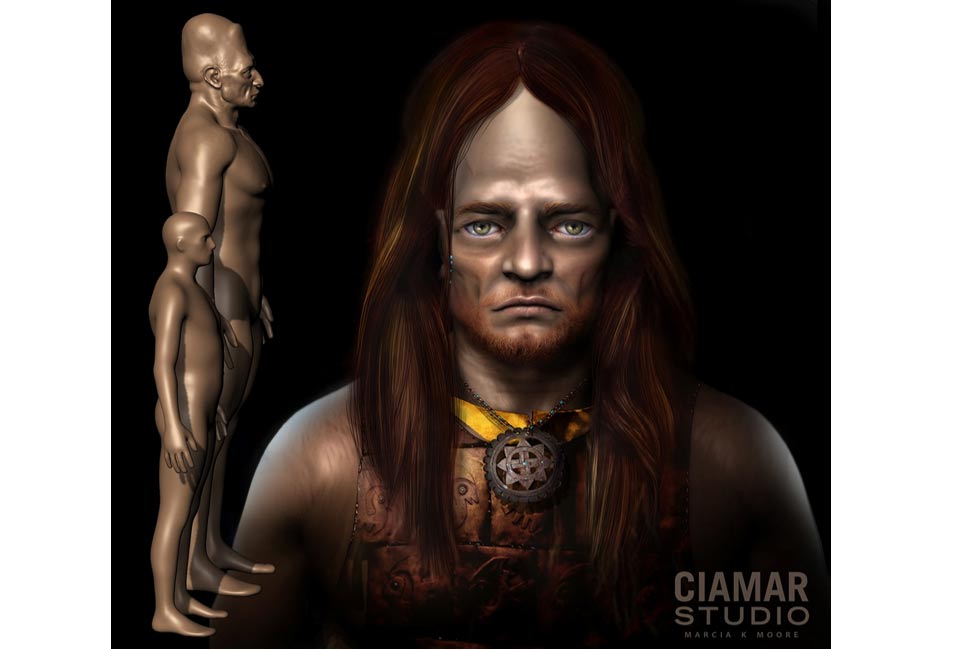
3d Digital Sculpture of Giant with hair,
copper breastplate, and gorget. Image courtesy of Marcia K. Moore, Ciamar
Studio. For more reconstructions of giants, visit Marcia K. Moore’s website.
It is common today for alternative history researchers to tell the story of how these beings were discovered en masse throughout the 19th and early 20th centuries. Historians, antiquarians, and archaeologists recorded the discovery of the Unique Physical Types all over the United States, with a large concentration found in the mounds and earthworks of the Ohio River Valley and along the Mississippi River. These accounts can be found in any number of county, township, and state histories, as well as anthropological literature from both inside and outside of the Smithsonian Institution. Here are several examples:
Kentucky: “From a mound on the farm of Edin Burrowes, near Franklin, were exhumed, in May, 1841, at a depth of over 12 feet, several human skeletons. One, of extraordinary dimensions, was found between what appeared to have been two logs, covered with a wooden slab. Many of the bones were entire. The under jaw-bone was large enough to fit over the jaw, flesh and all, of any common man of the present day. The thigh-bones were full six inches longer than those of any man in Simpson County. Teeth, arms, ribs, and all, gave evidence of a giant of a former race”. (History of Kentucky, Lewis Collins)
Jo Daviess County, Illinois: “The mounds on the bluff have nearly all been opened within the last two or three years…In all that have been opened the excavators have found in the center a pit that was evidently dug about two and a half feet below the original surface of the ground…The bones in this pit indicate a race of gigantic stature, buried in a sitting posture around the sides of the pit, with legs extending toward the center”. (The History of Joe Daviess County)
“Near the original surface, 10 or 12 feet from the center (of the mound), on the lower side, lying at full length upon its back, was one of the largest skeletons discovered by the Bureau agents, the length as proved by actual measurement being between 7 and 8 feet. It was all clearly traceable…” (12th Annual Report of the Bureau of Ethnology)
Kanawha Valley, West Virginia: “No 11 is now 35 by 40 feet at the base and 4 feet high. In the center, 3 feet below the surface, was a vault 8 feet long and 3 feet wide. In the bottom of this, among the decayed fragments of bark wrappings, lay a skeleton fully 7 feet long, extended at full length on the back, head west…. Nineteen feet from the top…in the remains of a bark coffin, a skeleton, measuring 7.5 feet in length and 19 inches across the shoulders, was discovered”. (12th Annual Report of the Bureau of Ethnology)
“Within the village of Brownstown, ten miles above Charleston and just below the mouth of Lens creek, is another such ancient burying ground…At Brownstown, not long since, two skeletons were found together, one a huge frame about seven feet in length and the other about four feet, a dwarf and deformed”. (History of the Great Kanawha Valley)
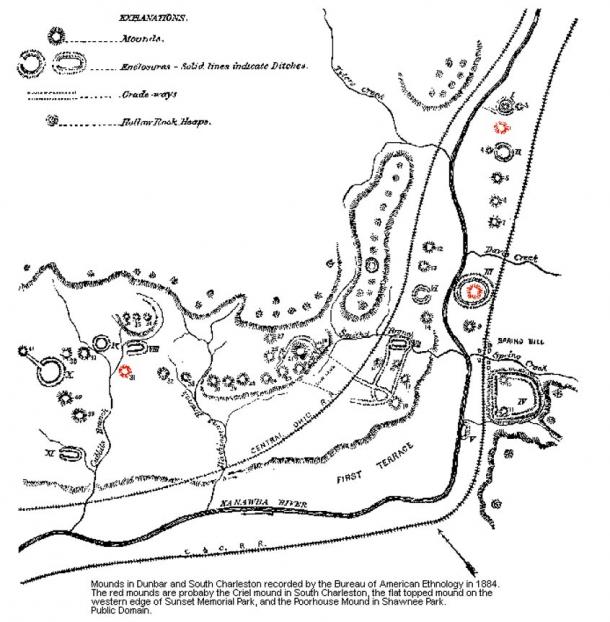
Florida: “Pursuing my investigations, and excavating further toward the south east face of the mound, I came upon the largest stone ax I have ever seen or that had ever been found in this section of the country. Close to it was the largest and most perfect cranium of the mound…Near by the side of this skull were the right femoris, the tibia, the humerus, and part of the radius, with a portion of the pelvis directly under the skull…Anticipating a perfect specimen in this skull, I was doomed to disappointment, for, after taking it out of the earth and setting it up, so that I could view the fleshless face of this gigantic savage, in the space of two hours it crumbled to pieces, except small portions. According to measurement of the bones of this skeleton, its height must have been quite 7 feet”. (Annual Report of the Boards of Regents of the Smithsonian)
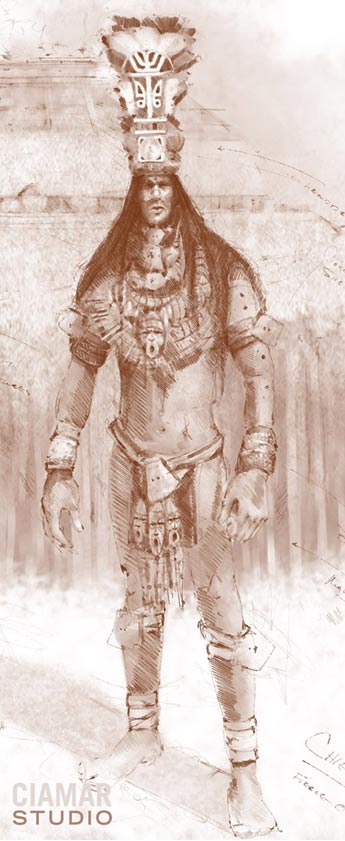
Digital sketch, ancient Florida giant. Image
courtesy of Marcia K. Moore, Ciamar Studio.
Louisiana: “In the same line of abnormality was the finding of one skull in which the detention reached the unusual number of forty teeth, the increase consisting of eight additional incisors…The formation of the skull found in the Larto mound, as compared with those of other localities, is highly anomalous…The anomaly in these cases cannot be ascribed to artificial disfiguration, for, were it such, the otherwise symmetrical development of the other parts would be impossible…their remarkable conformation could not possibly have been the result of bandages or other external appliances, but was undoubtedly congenital”. (Publication of the Louisiana Historical Society)
Etowah Mound Group: “Grave A, a stone sepulcher, 2.5 feet wide, 8 feet long, and 2 feet deep, was formed by placing steatite slabs on edge at the sides and ends, and others across the top. The bottom consisted simply of earth hardened by fire. It contained the remains of a single skeleton, lying on its back, with the head east. The frame was heavy and 7 feet long”. (12th Annual Report of the Bureau of Ethnology)
The samples from Illinois come from a region where Archaic era mounds have been found, often with Hopewell Mounds built over and into them hundreds or thousands of years later, as in the case of Elizabeth Mound 1 and Peter Klunk Mound 7. The Etowah Mound (Mound C) is ascribed to the Mississippian Cult, dated to 950-1450 AD.
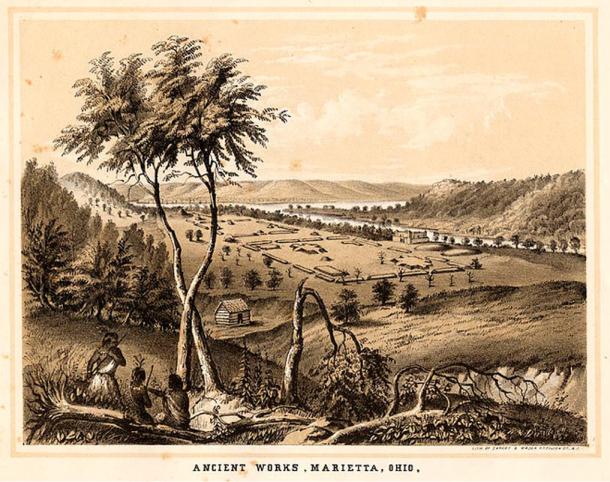
Ancient mounds and monuments of the
Mississippi Valley. Originally published in William Cullen Bryant and Sydney
Howard Gay, A Popular History of the United States, Vol I (1888), p. 24. (Wikimedia
Commons)
After the Government and Philanthropies took over American Archaeology in the 1900s, the establishment undertook the policy of flatly denying the existence of anomalous remains. The actual beginning point for the revisionist tendency in the National Museum was very early. By 1851, E G Squier was working to debunk theories of pre-Columbian contact, and several decades later, Gerald Fowke would attempt to discredit and jettison the work of virtually every researcher in the field up to his day, including the skeletal measurements of his fellow agents in the Bureau of Ethnology. However, the denial of the Unique Types truly got underway during the reign of Ales Hrdlicka as the Curator of Anthropology at the Smithsonian (circa 1903).
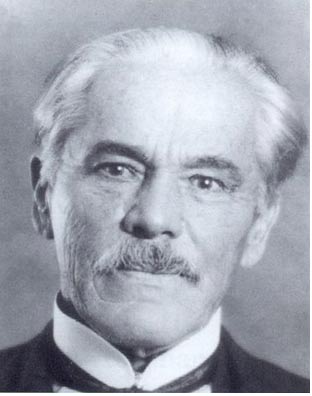
"Ales hrdlicka" by Unknown -
Archive Museum of Aleš Hrdlička in Humpolec. Licensed under CC BY-SA 3.0 via
Wikimedia Commons
"And
the ‘giant’ and ‘eight-foot’ skeleton is to this day the almost stereotyped
feature of many an amateur report of a find of skeletal remains in Florida as
well as other parts of the country. All these reports…it may be said once and
for all, are exaggerations."
Interestingly, Hrdlicka’s name appears in several reports of discoveries of gigantic skeletons during his tenure at the American Museum:
"The
skeletons of these Hitherto Unknown American Aborigines Showed They All Ranged
in Height from Six and One-Half to Seven Feet…Excavating in the sand dunes of
the sun-sprayed Golden Isles, Georgia, archaeologists have gouged out the
strange record of an amazing prehistoric race of giants…What manner of men were
these, the members of whose tribe all averaged six and one-half and seven feet
tall?...Some of the first skulls to be disinterred by Preston Holder have
already been examined at the Smithsonian Institute by Dr Ales Hrdlicka,
foremost authority on North American Types."
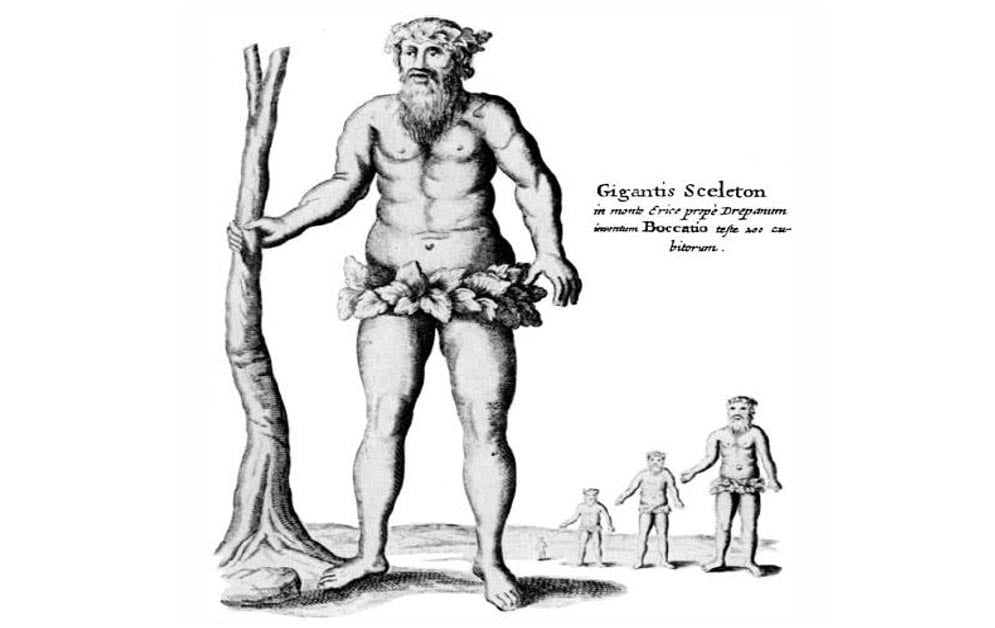
Illustration from "Mundus
subterraneus" - suggesting that fossil bones were from giants (Wikimedia Commons).
Following our overview of discoveries of gigantic humanoid skeletons in the burial mounds and associated graveyards of the Adena-Hopewell, Archaic Cultures, and Southeastern Ceremonial Complex, we will now document the discovery of the Unique Physical Types (UPT) even after the institution of the mainstream policy of denial, or “post cover-up”.
The two pre-eminent Adena scholars of the twentieth century were William S Webb (assisted by Charles Snow of the University of Kentucky) and Don Dragoo, of the Carnegie Museum. When Webb excavated the Dover Mound in Mason Co, Kentucky, he encountered a group burial of 4 skeletons, one of which represented the Unique Physical Type:
“The remains of burial 40 is one of the largest known to Adena; the skull-foot field measurement is 84 inches (7 feet).” (The Dover Mound, William S Webb and Charles Snow 1959)
The Burial Census Table mentions that this skeleton had a “very thick” skull and represented the “tallest Adena male” from the mound. For other burials in the Dover Mound the Table includes such details as “prominent bilateral chin”, “rugged head and face, wide bilateral chin” and “High Vaulted, large-faced”. (Webb and Snow, 1959)
The Dover Mound also yielded skeletons with dental abnormalities. Burial 54 included “a supernumerary tooth with twin cusps, lying diagonally in the left maxilla”, as well as “shovel shaped later incisors.” (Webb and Snow, 1959)
Recently recorded instances of Adena supernumerary teeth occur at McMurrey Mound 1 and Sidner Mound 1 in Ohio. (Mortuary Variability in the Middle Big Darby Drainage of Central Ohio Between 300 BC and 300 AD Volume 1, Bruce Aument). One particularly monstrous deformation analyzed and photographed in the Ohio Archaeologist may be an extreme case of the type of dental anomalies found in the Dover Mound. (Ohio Archaeologist, 10(4), Oct 1960.)
“Not only do the Dover people show the results of head shaping (deformation), but they exceed the total Kentucky series in the great width and height of the skull vault!...it is to be noted that the head shaping…has been extreme in these skulls…These people as a group…have the highest skull vaults reported anywhere in the world.” (Webb and Snow, 1959)
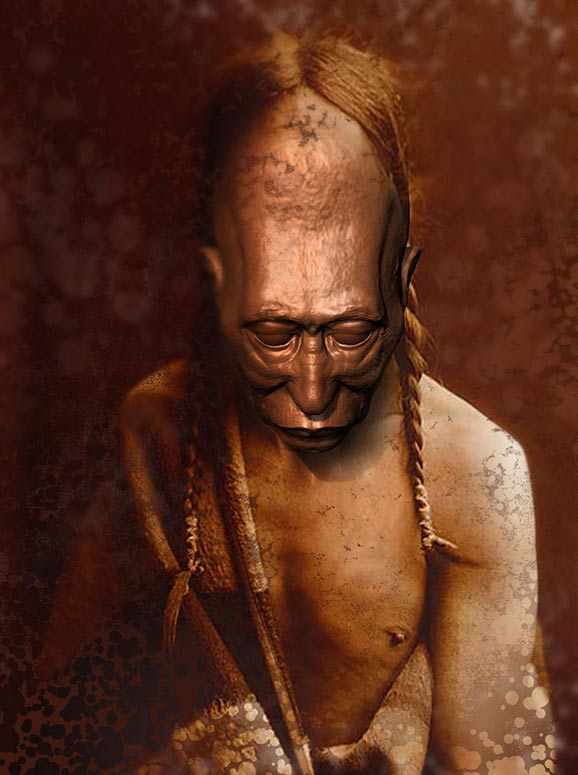
Artist’s reconstruction of the high skull
vaults reported in descriptions of North American giants. Image courtesy of Marcia K. Moore, Ciamar Studio.
Another feature of the UPTs documented by Webb and Snow is the massive lower jaw:
“One of the outstanding and un-Indian traits present among the Adena people is their prominent and often bilateral chins…One of the skulls from the Dover Mound, Burial 25…represents a bilateral chin with a width of 52 mm.” (Webb and Snow, 1959)
“One of the particular features present in at least one-half of the observed examples is the great width of the bony chin, formed by bilateral eminences rarely found among the skulls of the much earlier Shell Heap People or among the later Hopewell People.” (The Adena People, No 2, by Webb and Baby).
Besides the large skeletal type, Snow noted the discovery of the “Dwarf” type mentioned in early literature in his observations of the famous Adena pipe from Ross County, Ohio:
“Further evidence of abnormal Adena individuals is portrayed in a remarkable piece of sculpture in the round-the Adena Pipe figurine…The figure depicted is typical of this form of dwarfism.” (The Adena People, No 2, by Webb and Baby.)
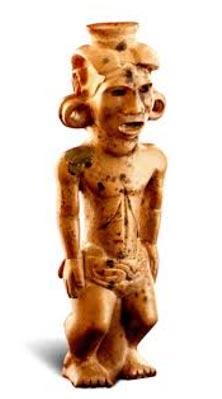
The Adena Pipe. His head and torso are large
in comparison to his legs, suggesting to some that he represents a dwarf.
(Photo courtesy of the Ohio Historical Society)
The text references the excavation of one of these individuals at Waverly, Ohio. The following description of this burial is from Gerald Fowke:
“…a skeleton of peculiar form. It was not over five feet long, but the bones were very thick and the processes for attachment of muscles were extraordinary in their development. The skull was nearly half an inch thick and of unusual size, mostly back of the ears, though the forehead was full and high. The teeth were large, hard, and but little worn”. (The Archaeological History of Ohio, by Gerald Fowke, page 372.)
In 1958, Don Dragoo encountered the large Adena type while excavating the Cresap Mound in West Virginia on behalf of the Carnegie Museum. In a subfloor tomb he unearthed Burial 54:
“This individual was of large proportions. When measured in the tomb his length was approximately 7.04 feet. All the long bones were heavy and possessed marked eminences for the attachment of muscles.” (Mounds for the Dead, by Don Dragoo, 1963).
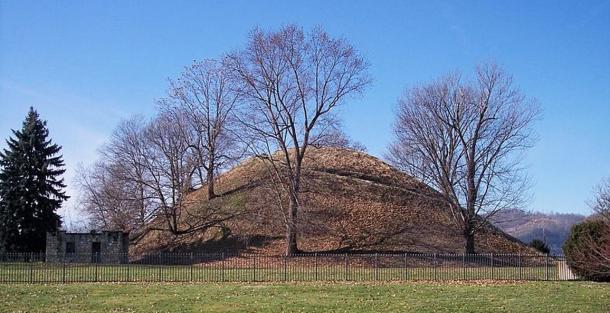
A burial mound of the Adena Culture. Grave
Creek Mound in Moundsville, West Virginia (Wikimedia Commons)
This discovery, as well as a review of Webb’s earlier work at the Dover Mound, influenced Dragoo’s remarkable observations on Adena anthropology:
“Two outstanding traits have been noted repeatedly for this group. One is the protruding and massive chin often with prominent bilateral protrusions. The second trait is the large size of many of the males and some of the females. A male of six feet was common and some individuals approaching seven feet in height have been found, for example, Burial 40 in the Dover Mound and Burial 54 in the Cresap Mound. Some of the females in the Dover Mound also were more than six feet in height. Not only were these Adena people tall but also the massiveness of the bones indicates powerfully built individuals. The head was generally big with a large cranial capacity”. (Mounds for the Dead, by Don Dragoo, 1963).
To Webb, Snow, and Dragoo, the evidence clearly pointed towards the existence of a group of genetically related elites within the Adena sphere who shared the UPT traits. The true number of these individuals had been obfuscated by the common practice of cremation:
“If, as the evidence seems to indicate, the burials in the tombs were those of a selected group such factors would have undoubtedly been of importance not only in the development of the prominent chin but also in the large stature. If only certain inbreeding individuals of the total population were members of the ‘selected group’, genetic factors would also have played an important part in the establishment of the unique Adena physical type…How wide-spread throughout the entire Adena population were the unique traits of the tomb burials is unknown but Snow’s study of the cremated remains from the Dover Mound indicated that at least some of the individuals among these cremated remains also possessed the unique traits of the flesh burials in the tombs. Because of the common practice of cremating most of the dead, we will probably never be able to determine the full extent of these special traits in the general population.” (Mounds for the Dead, by Don Dragoo, 1963).
The emerging picture is of an elite race within Late Archaic/Early Woodland societies who were often buried in the mounds, and who represented a type of “royalty”. Among these interrelated groups were UPTs. This elitism is further evidenced by the presence of extensive child and infant burials in the tombs, often accompanied by the same exotic goods as the adults including shell beads and copper rings. Also, dental and bone anomalies have been used to establish a genetic connection between individuals at mound sites.
Gigantic discoveries are often challenged with the generic statement that average Adena were between 5’6’’ and 5’11’’ feet tall, but this argument is a conjecture of half-truth disguised as science. We are not concerned with the “average” stature of the Adena populace, but rather the irregular characteristics (and often abnormally tall stature) of their elite.
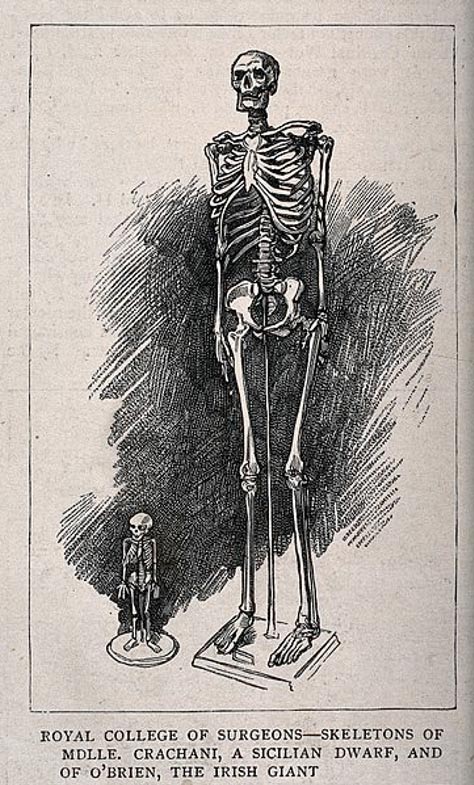
Skeletons of a male giant and a female dwarf,
displayed at the Royal College of Surgeons. (Wikimedia Commons)
Besides the professional literature, so-called “amateur” archaeologists have also chronicled conclusive evidence of Unique Physical Types with a great consistency to the discoveries of Dragoo and Webb. In 1908, Louis Welles Murray recorded that at Tioga Point in Pennsylvania, remains of “a skeleton of a man six or more feet in height” beneath a cist-like grave were found. The grave itself was encased and moved to the local museum where the bones were studied by hundreds of people. Other skeletons from this same area “were of unusual size; one, judged from the length of thigh bone, to be seven feet.” (A History of Old Tioga Point and Early Athens, Pennsylvania, by Louis Welles Murray.)
In addition to these, Murray documents the examination of a large skeleton by a Professor Holbrooke:
“Judging by the thigh bone he must have been seven feet tall. The skull was much larger than usual, very thick, the forehead unusually receding, the top flattened. The jaws were extremely strong, full of large, perfect teeth.” (A History of Old Tioga Point and Early Athens, Pennsylvania, by Louis Welles Murray.)
Following the discovery of burials in her own flower garden, Murray embarked on an archaeological odyssey of her own. In 1921, she published an article for the American Anthropologist, noting that the femur, jaw, and teeth of one of the seven-foot skeletons was then still in the Tioga Point Museum. Also included are references to many skeletons between 6 and 7 feet tall, with photographs of artifacts, pottery, and the in situ burial of one of the “above 6ft” burials. The article also features a photograph of the “Paul Scott Collection”, described as “a multiplicity of small artifacts, suggesting a race of pygmies” which included a “miniature amulet and sinker stones.” (Aboriginal Sites In And Near “Teaoga”, in American Anthropologist 23(2) 1921).
Regardless of the disparagement of amateurs, historians, and antiquarians, the credentials of Webb, Snow, and Dragoo have never been brought into question. With so many researchers scrambling today to discover irrefutable evidence of gigantic or otherwise anomalous beings to prove their existence, the authors question why they do not simply present the works of William S Webb and Don Dragoo to anthropologists, and more importantly, their audiences.
While the concept of a mysterious and undiscovered race may create an air of sensationalism healthy for selling books and DVDs, we feel that it is of far more relevance to demonstrate that the Unique Physical Types were discovered by professionals all the way up through the 20th century, even after the institutionalized policy of denial, and yet the establishment continues to deny their own documented evidence and the truth.
References:
History of Kentucky, Volume 2. Lewis Collins, 1878. Giants appear in the text on pages 107, 653, 654, 666, 683, and 722 https://archive.org/stream/collinshistoricav02coll#page/n7/mode/2up
The History of Joe Daviess County, Illinois, 1878. Reference is page 843 https://archive.org/stream/historyofjodavie00kett#page/844/mode/2up/search/Ancient+Mounds
12th Annual Report of the Bureau of Ethnology, 1891. https://archive.org/stream/annualreportofbu1218901891smit#page/n7/mode/2up
History of the Great Kanawha Valley, by John P Hale, 1891. Reference on page 47.
https://archive.org/stream/historyofgreatka01madi#page/n7/mode/2up
Annual Report of the Boards of Regents of the Smithsonian, 1874. See Antiwuities of Florida, page 392.
Publications of the Louisiana Historical Society 1896. Mounds of Louisiana, Part 1. Reference begins on page 20.
https://archive.org/stream/publicationslou02socigoog#page/n143/mode/2up
Building Woodland Archaeological Units in The Kanawha River Basin, West Virginia, by Patrick D Trader, in Woodland Period Systematics in The Middle Ohio Valley, edited by Darlene Applegate and Robert Mainford, 2005.
For Elizabeth Mound number 1, see The Archaic and Woodland Cemeteries of the Elizabeth Site in the Lower Illinois Valley edited by Leigh and Buikstra, 1988.
For Peter Klunk Mound 7, see Hopewell and Woodland Site Archaeology in Illinois, Bulletin 6 Illinois Archaeological Survey
https://uofi.app.box.com/s/gw2ah1c1wyi602w27umt
Essay attached to Memoir on the European Colonization of America, page 20.
https://archive.org/stream/cihm_42357#page/n23/mode/2up
Archaeological History of Ohio, Gerald Fowke.
https://archive.org/stream/cu31924005690155#page/n5/mode/2up
Anthropology of Florida, Ales Hrdlicka 1922.
https://archive.org/stream/anthropologyoffl00hrdli#page/n5/mode/2up
Newspaper article discovered in a clipping file by Ross Hamilton, author of A Tradition of Giants: The Elite Social Hierarchy of American Prehistory.
The Salt Lake Tribune, 8/21/1936, courtesy of the excellent Greater Ancestors website:
http://greaterancestors.com/the-golden-isles-giants/
The Dover Mound, William S Webb and Charles Snow 1959. The measurement of the giant is on page 22, the burial census is on pages 29-32, and the dental anomalies are photographed on page 43.
Mortuary Variability in the Middle Big Darby Drainage of Central Ohio Between 300 BC and 300 AD Volume 1, Bruce Aument.
Ohio Archaeologist, 10 (4), Oct 1960. Article and photograph on pages 140-141.
https://kb.osu.edu/dspace/bitstream/handle/1811/55999/OHIO_ARCHAEOLOGIST_10_4_OCTOBER_1960.pdf?sequence=1
The Adena People, No 2, by Webb and Baby.
The Archaeological History of Ohio, by Gerald Fowke, page 372.
Mounds for the Dead, by Don Dragoo (1963). Burial 54 is measured and described on page 67, and an actual photograph of the skeleton in situ appears on page 50.
A History of Old Tioga Point and Early Athens, Pennsylvania, by Louis Welles Murray. Large Skeletons appear in the text around page 200. Page 203 features a photo of a large type in situ.
https://archive.org/stream/ahistoryoldtiog00murrgoog#page/n8/mode/2up
Aboriginal Sites In And Near “Teaoga”, Now Athens, Pennsylvania, in American Anthropologist 23(2) 1921 page 183. The article features a photo of the “pygmy artifacts”.
From Ancient Origins @ http://www.ancient-origins.net/unexplained-phenomena/establishment-has-already-acknowledged-lost-race-giants-part-1-003109
and http://www.ancient-origins.net/unexplained-phenomena/establishment-has-already-acknowledged-lost-race-giants-part-2-003114
For more information about giants see http://nexusilluminati.blogspot.com/search/label/giants
- Scroll down
through ‘Older Posts’ at the end of each section
Hope you like this
not for profit site -
It takes hours of work every day by
a genuinely incapacitated invalid to maintain, write, edit, research,
illustrate and publish this website from a tiny cabin in a remote forest
Like what we do? Please give anything
you can -
Contribute any amount and receive at
least one New Illuminati eBook!
(You can use a card
securely if you don’t use Paypal)
Please click below -
Spare Bitcoin
change?
For further enlightening
information enter a word or phrase into the random synchronistic search box @
the top left of http://nexusilluminati.blogspot.com
And see
New Illuminati – http://nexusilluminati.blogspot.com
New Illuminati on Facebook - https://www.facebook.com/the.new.illuminati
New Illuminati Youtube Channel - http://www.youtube.com/user/newilluminati
New Illuminati on Google+ @ https://plus.google.com/115562482213600937809/posts
New Illuminati on Twitter @ www.twitter.com/new_illuminati
New Illuminations –Art(icles) by
R. Ayana @ http://newilluminations.blogspot.com
The Her(m)etic Hermit - http://hermetic.blog.com
DISGRUNTLED SITE ADMINS PLEASE NOTE –
We provide a live link to your original material on your site (and
links via social networking services) - which raises your ranking on search
engines and helps spread your info further!
This site is published under Creative Commons (Attribution) CopyRIGHT
(unless an individual article or other item is declared otherwise by the copyright
holder). Reproduction for non-profit use is permitted
& encouraged - if you give attribution to the work & author and include
all links in the original (along with this or a similar notice).
Feel free to make non-commercial hard (printed) or software copies or
mirror sites - you never know how long something will stay glued to the web –
but remember attribution!
If you like what you see, please send a donation (no amount is too
small or too large) or leave a comment – and thanks for reading this far…
Live long and prosper! Together we can create the best of all possible
worlds…
From the New Illuminati – http://nexusilluminati.blogspot.com
No comments:
Post a Comment
Add your perspective to the conscious collective